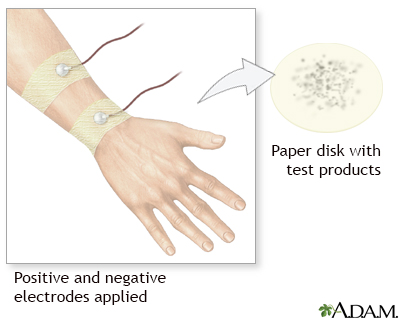Sweat electrolytes test
Sweat test; Sweat chloride; Iontophoretic sweat test; CF - sweat test; Cystic fibrosis - sweat test
Sweat electrolytes is a test that measures the level of chloride in sweat. Sweat chloride test is the standard test used to diagnose cystic fibrosis (CF).

The sweat electrolyte test is a test that measures the level of chloride in sweat. In children, increased sodium and chloride concentrations in sweat can indicate cystic fibrosis, an inherited disease that affects the respiratory and digestive system.

The sweat electrolyte test is performed to determine the amount of chloride that is excreted in sweat from the body during a certain period of time. The test may be performed on infants to determine if cystic fibrosis is present. Children with cystic fibrosis have increased sodium and chloride concentrations in their sweat.
How the Test is Performed
A colorless, odorless chemical that causes sweating is applied to a small area on an arm or leg. An electrode is then attached to the spot. A weak electrical current is sent to the area to stimulate sweating.
People may feel a tingling in the area, or a feeling of warmth. This part of the procedure lasts for about 5 minutes.
Next, the stimulated area is cleaned and the sweat is collected on a piece of filter paper or gauze, or in a plastic coil.
After 30 minutes, the collected sweat is sent to a hospital lab to be tested. The collection takes about 1 hour.
How to Prepare for the Test
No special steps are needed before this test.
How the Test will Feel
The test is not painful. Some people have a tingling feeling at the site of the electrode. This feeling may cause discomfort in small children.
Why the Test is Performed
Sweat testing is the standard method for diagnosing cystic fibrosis. People with cystic fibrosis have higher amounts of sodium and chloride in their sweat that are detected by the test.
Some people are tested because of symptoms they are having. In the United States, newborn screening programs test for cystic fibrosis. The sweat test is used to confirm these results.
Normal Results
Normal results include:
- A sweat chloride test result of less than 30 mmol/L in all populations means cystic fibrosis is less likely.
- A result between 30 to 59 mmol/L does not give a clear diagnosis. Further testing is needed.
- If the result is 60 mmol/L or greater, cystic fibrosis is present.
Note: mmol/L = millimole per liter
Normal value ranges may vary slightly among different laboratories. Talk to your health care provider about the meaning of your specific test results.
Some conditions, such as dehydration or swelling (edema) can affect the test results.
What Abnormal Results Mean
An abnormal test may mean that the child has cystic fibrosis. Results can also be confirmed by CF gene mutation panel testing.
References
Egan ME, Schechter MS, Voynow JA. Cystic fibrosis. In: Kliegman RM, St. Geme JW, Blum NJ, Shah SS, Tasker RC, Wilson KM, eds. Nelson Textbook of Pediatrics. 21st ed. Philadelphia, PA: Elsevier; 2020:chap 432.
Farrell PM, White TB, Ren CL, et al. Diagnosis of cystic fibrosis: consensus guidelines from the Cystic Fibrosis Foundation. J Pediatr. 2017;181S:S4-S15.e1. PMID: 28129811
Siddiqi HA, Rabinowitz S, Axiotis CA. Laboratory diagnosis of gastrointestinal and pancreatic disorders. In: McPherson RA, Pincus MR, eds. Henry's Clinical Diagnosis and Management by Laboratory Methods. 24th ed. Philadelphia, PA: Elsevier; 2022:chap 23.
Version Info
Last reviewed on: 4/25/2023
Reviewed by: Charles I. Schwartz, MD, FAAP, Clinical Assistant Professor of Pediatrics, Perelman School of Medicine at the University of Pennsylvania, General Pediatrician at PennCare for Kids, Phoenixville, PA. Also reviewed by David C. Dugdale, MD, Medical Director, Brenda Conaway, Editorial Director, and the A.D.A.M. Editorial team.
